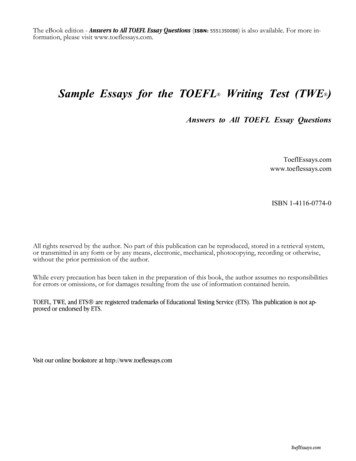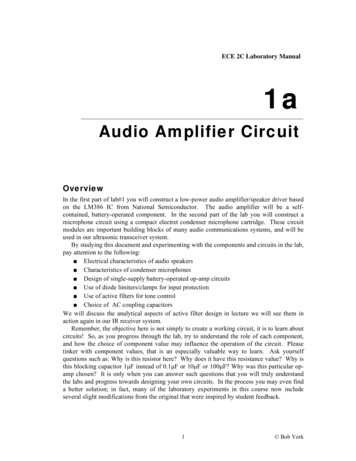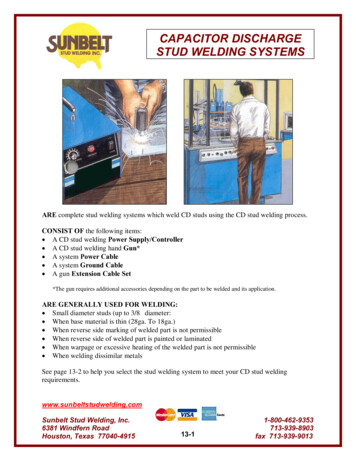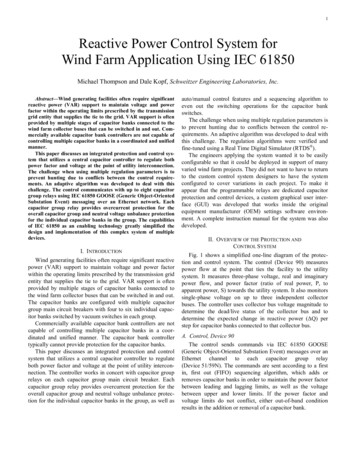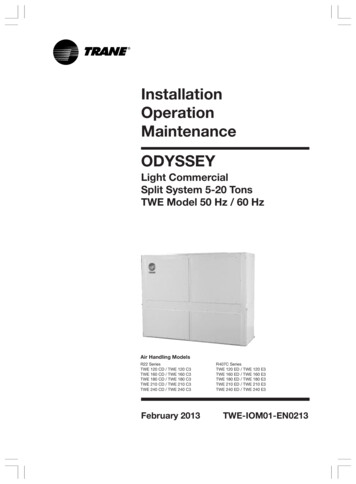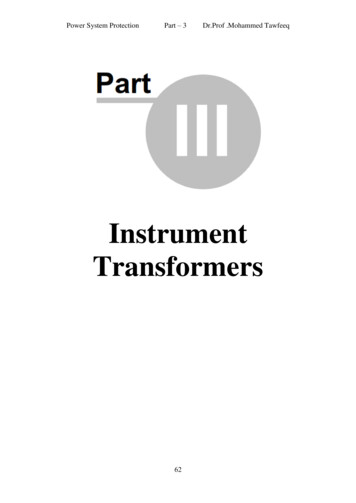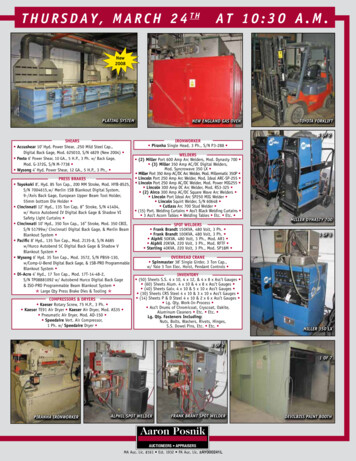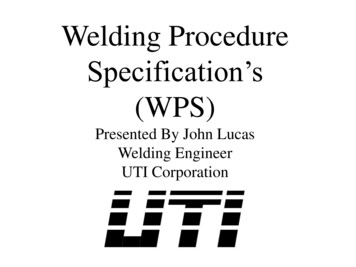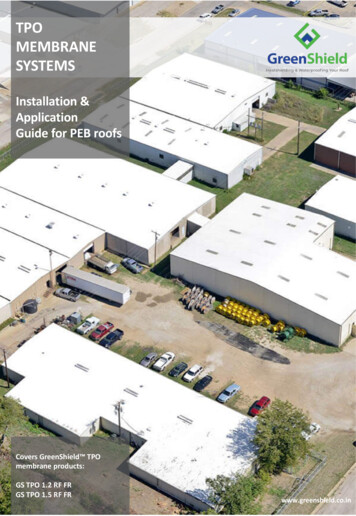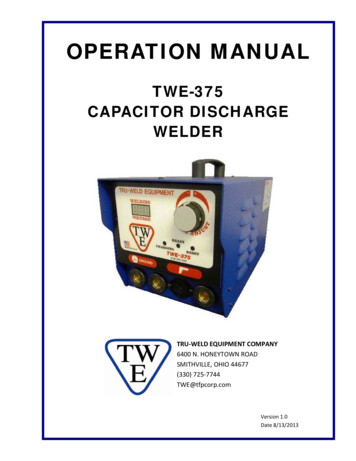
Transcription
OPERATION MANUALTWE-375CAPACITOR DISCHARGEWELDERTRU‐WELD EQUIPMENT COMPANY6400 N. HONEYTOWN ROADSMITHVILLE, OHIO 44677(330) 725‐7744TWE@tfpcorp.comVersion 1.0Date 8/13/2013
TRU‐WELD EQUIPMENT LIMITED WARRANTYAll goods produced by Truweld Equipment shall be warranted against defects including workmanship and components. No other war‐ranties whether expressed, verbal, or implied will apply. Warranties only apply to the original equipment purchaser.Warranty claims will be limited to either repair or replacement of the defective materials by Truweld Equipment. At the option of Tru‐weld Equipment the location of where the warranty evaluation and repairs are made will be determined. All warranty claim items re‐turned to Truweld Equipment will be at the customer’s expense. At the option of Truweld Equipment the defect will either be repairedor replaced. Notice must be provided to Truweld Equipment of a warranty defect within 30 days that the defect or failure is incurred.Warranties are not transferable.This warranty does not apply for equipment which is used improperly in any fashion including but not exclusive to the following:Equipment which has been modifiedEquipment which has not been installed properlyEquipment which has been used for purposes other than which it had been designedEquipment which has not been properly maintainedEquipment which was continued to be used after a defect had been foundEquipment which was damaged in any wayTruweld Equipment will never be liable for consequential damages, loss, or expense occurring directly or indirectly from the use of theequipment covered in this warranty.All cables, cable sets and connectors are not warranted.Two (2) year warranty period from date of purchaseSC3402 Power SupplySC3400 Power SupplySC2420 Power SupplySC2402 Power SupplySC2400 Power SupplySC1900 Power SupplySC1950 Power SupplySC1600 Power SupplySC1650 Power SupplySC1400 Power SupplySC1450 Power SupplySC900 Power SupplyTWE250 Power SupplyTWE321 Power SupplyTWE375 Power SupplyOne (1) year warranty period from date of purchaseTWESPC Power SuppliesTWP‐2Power SupplyNinety Day warranty period from date of purchase(Excluding cables and connectors)TWE70000 HD Arc stud gunTWE18500 MD Arc stud gunTWE19000 LD Arc stud gunTWEG CD stud gunTWEHDG Heavy Duty CD stud gun2
CONTENTSSectionDescriptionPages1Warranty22Table of Contents33Product Specs and Features44Introduction55External Features6‐76Safety8‐107Setup And Welding11‐178Testing Weld Settings18‐199Internal Components20‐2210CD Stud Gun Exploded View233
Product FeaturesModel: TWE‐375Stud Welder DescriptionIncorporates the latest solid state technology into a compact and rugged CD Stud Welder. This sys‐tem has the capacity to weld studs and pins (including cupped head pins) ranging from 14‐gaugethrough 3/8” full flanged stainless steel studs.SPECSTWE‐375SIZE16” Length, 8‐1/2” Width, 9” HeightWEIGHT34 lbs.WELD RANGE14 gauge through 3/8” StainlessDUTY CYCLE30 studs per minute (including 3/8”)PRIMARY POWER110 VAC @ 50/60Hz 10 Amp circuit or 220 VAC @50/60Hz5 Amp circuitCHARGE VOLTAGE35‐200 VDCOperational and Safety Features LED Voltage Meter Safety Shutdown Cooling Fan Front‐Panel Informational LED’s Dial‐Down weld voltage control Digital DC voltage readout on all models (allows for more accurate and repeatable weld settings). Cooling fan in all models for increased efficiency. Dial‐down DC voltage setting (no need to turn off the unit when resetting to a lower voltage). Only 10 amp circuit requirement (unit fused @ 10 amps). 99,000 micro farad capacitors charging to 200 VDC for greater power output @ lower DC voltage requirements. Terminal connections on the capacitors are over 5/8” in diameter for a good seat of the terminal buss bars to increase reliability. The terminal connections on the capacitors have 1/4‐28 socket set screws inserted into each one. The socket set screw is used tomake the connection to the buss bar. This eliminates damaging the threads in the aluminum connectors of the capacitor, ensuringa solid connection. Rigid internal construction connecting the entire internal unit to the front and rear panels minimizes the opportunity of the com‐ponents coming loose during handling or operations. Sheet metal is powder‐coated for greater durability, texture, and appearance. Stud Guns are ergonomically designed for better hand fit and comfort (reduces operator fatigue for increased weld repeatability). Stud Guns have a permanent internal spring with easy adjustment for various spring pressures allowing an increased opportunityto apply the correct spring pressure to the weld (no need for a variety of different springs for various applications). Stud Guns can be configured for “B” Collets, “CI” Collets, Euro Collets or standard tapered chucks.4
INTRODUCTIONThe complete range of the capacitor discharge equipment is compact, portable studwelding equipment. The units are specifically designed to enable a small diameterrange of ferrous and nonferrous weld studs to be welded to light gauge metal materi‐als with little or no reverse‐side marking.The equipment consists of a control unit, a welding hand gun, and all necessary inter‐connecting cables.THE PROCESSCapacitor Discharge (CD) stud welding is a form of welding in which the energy re‐quired for the welding process is derived from a bank of charged capacitors. Thisstored energy is discharged at the base of the specially designed CD stud and it fusesthe stud to the base material. The time of the weld is determined in such a short du‐ration that no burn through marking is made on the finish side of the material.CONTACTIn contact CD welding, the stud is placed under spring pressure on the material to bewelded. When the capacitors are discharged, the special tip of the CD stud melts andthe spring pressure forces the stud to fuse with the base material.5
EXTERNAL FEATURESFRONT PANEL1234561. Weld Voltage Selector ‐ rotate to change to required voltage.2. Welding Voltage Digital Display ‐ displays selected voltage.3. LED Lights ‐ Charging (capacitors are being charging to desired voltage), Ready(unit is ready to weld), Reset (indicates an error and unit should be turned off).4. Welding Ground Cable Connector ( )5. Stud Gun Control Connector6. Welding Stud Gun Cable Connector (‐)6
EXTERNAL FEATURESREAR PANEL1.On/Off Switch2.Circuit Breaker3.AC Power Cord4.Manufacturer Model Number and Serial Number PlateWARNING!This unit operates from a 110 VAC 60 Hertz @10 amp circuitor 220 VAC 50 Hertz @ 5 amp circuit.Do not obstruct the ventilation fan, as this may cause unit to over heat.Do not remove any portion of the unit housing without first disconnecting the unitfrom the power supply.ON/OFF SwitchPower Supply Fan15Amp Circuit BreakerAC Cord7
SAFETYPROTECT YOURSELF AND OTHERS!Read the safety notices before using welder.ELECTRICALNo portion of the outer cover of the welding controller should be removed by any‐one other than qualified personnel. Always disconnect the unit from the main powerprior to removing cover. This equipment contains a transformer power supply system, which is energizedby AC current and transforms the AC to DC current. Due to potential dangerouselectrical input and output the equipment must be disconnected from all incom‐ing power when servicing. Capacitors store electrical energy. Check for residual charge before performingany maintenance. Do not use fluids to clean electrical components as these may penetrate the elec‐trical system and cause shorts.Connection of the unit into service must be in accordance with the setup proceduresas detailed in this manual. Operation of this equipment must be in accordance withall local, regional, and national safety codes.8
SAFETYFIREDuring welding, small particles of hot metal can be expelled. Ensure that no combus‐tible materials are near the welding area.FIRE HAZARDFROM SPARKSPERSONAL SAFETYArc rays can burn your eyes and skin. Wear protective clothing and eye protectionwhen welding.Loud noises from welding can damage hearing. Wear earplugs or other protectivegear, if applicable.Fumes and gases expelled during welding can be hazardous to your health. Makesure welding is done in a well‐ventilated area.Hot metal splatter can cause fires and burns. Wear protective clothing, free of com‐bustible materials. Have a fire extinguisher nearby and know how to use it.MAINTENANCEAll cables must be inspected regularly to ensure that no danger exists from worn ordamaged insulation or unsafe electrical connections. Take special note to the cablesnear the stud gun ‐ this is where maximum wear occurs.Worn cables not only produce inconsistent welds, but can overheat or spark.9
SAFETYTRAININGUse of this equipment must be limited to authorized personnel only. They must beadequately trained, and have read and understood everything in this manual. Themanual must be available to operators at all times.AUTHORIZEDPERSONNEL ONLYINSTALLATIONSelect a site for the equipment which is capable of supporting the weight of theequipment, which is clear from traffic routes where people may trip over cables, orthey may be damaged by other equipment or vehicles.Do not hang connecting cables over sharp edges or have near heat sources.DISPOSALThe equipment, in its entirety or as components/parts may be disposed of as generalindustrial waste or scrap. None of the components used in the manufacturing of theCD Welders are toxic, carcinogenic, or otherwise harmful to your health.10
SET-UP AND WELDINGPOWERING UP THE EQUIPMENTSetup the equipment power supply (Control Unit) and connect to the main power,making certain of the proper voltage requirement of the particular unit.Capacitor Discharge (CD) units generally require 110 VAC @ 60Hz incoming power.Refer to the safety recommendations before plugging this unit in.ON/OFF SwitchCircuit BreakerPower Cord (110 VAC)CONNECTING THE WELDING LEADSConnect the welding ground cable into the ( ) terminal mount socket on the front ofthe welding unit.***NOTE ‐ the cable end plug has a flat which aligns with a dot on the panel mountsocket. Secure the connector into the panel mount socket, and then turn it clockwiseuntil it locks into proper position. Failure to do so could result in damage to the con‐nector.Ground Cable Socket11
SET-UP AND WELDINGCONNECTING THE WELDING LEADSConnect the welding stud gun power cable into the (‐) terminal panel mount socket(designated by the gun symbol) on the front of the welding unit.***NOTE ‐ the cable end plug has a flat which aligns with a dot on the panel mountsocket. Secure the connector into the panel mount socket, and then turn it clockwiseuntil it locks into proper position. Failure to do so could result in damage to the con‐nector.Welding Gun Power ConnectorWelding Gun Control Cable ConnectorConnect the weld gun control cable into the center panel 2‐pin socket.**NOTE ‐ the plug has a large pin and a small pin that match the socket on the unit.This is to prevent incorrect connections. Push the plug firmly into the socket andtwist clockwise to secure the plug into the correct position.12
SET-UP AND WELDINGCONNECTING THE GROUND CLAMPAttach the clamp of the welding ground lead to the work piece. Prior to securing theclamp, make certain that the contact area is free of rust, paint, grease, or any otherimpurities to ensure a good ground connection.NOTE***Most applications will require only one ground clamp, but certain applica‐tions will require an additional dual clamp.13
SET-UP AND WELDINGSELECTING THE PROPER STUD COLLET (STUD HOLDER)The collet is selected to the proper diameter that you are welding.There are three styles of collets; The “B” collet which is a two‐piece assembly (collet and insert). The insert deter‐mines how much of the stud is engaged in the collet. The CI (Collet Insert) which is a single part and the amount of the stud that is en‐gaged is predetermined. Standard Adjustable Chucks have an adjustable internal screw to manually adjustfor the engagement of the stud.The choice between these systems is usually a matter of personal preference.Inserting the selected collet into the stud gun is a simple task. Place the collet intothe front holder of the stud gun and set the locking screws to hold it in place.After inserting the collet, mount the two legs and foot piece onto the stud gun. Thecollet should be centered through the opening of the foot piece.Foot PieceColletLeg PieceWhen the legs and foot piece are in place, insert the stud to be welded into the col‐let. Adjust the leg and foot piece by sliding it into position until approximately 1/8”of the stud protrudes from beyond the foot piece. Lock legs in place with the setscrews.14
SET-UP AND WELDINGSELECTING THE SPRING LOADThe proper spring pre‐load setting on the stud gun will vary depending on the se‐lected application. Generals rules of application would be; mild steel or stainlesssteel usually in the 1 to 2 range, depending on the stud diameter and the thickness ofthe base material. Aluminum and other nonferrous metals would require settingsfrom 3 to 5 depending on the diameter of the stud and base material thickness.Adjustment CapTension IndicatorThis spring pre‐load adjustment is made by turning the back cap of the stud gun. Onthe side of the stud gun is the indicator numbered 1 thru 5, which will show you thetension setting during the adjustment.Location of adjustmenton back of the gun.15
SET-UP AND WELDINGREADY FOR WELDINGWhen you have completed all of the previous steps to prepare for welding, includingconnecting the stud gun and ground cables to the unit, attaching the ground cable(s)to the work area, setting up and adjusting the stud gun for the selected stud diame‐ter and material, you can now power on the welder.ON/OFF SWITCHCircuit BreakerThe controller ON/OFF switch is located on the rear of the unit in the upper righthand corner. Below this switch is the 15amp fuse holder for the system.16
SET-UP AND WELDINGVOLTAGE SELECTIONSelecting the required weld voltage is achieved by turning the selector knob. Thevoltage range is from 35VDC to 200VDC.The voltage is determined by the diameter of the stud and the base material.Voltage Adjustment KnobApproximate voltage staring points are listed below. Fine tuning the voltage to meetyour requirement for your specific application is recommended.MODEL TWE‐250DiameterMODEL TWE‐375 & 375Voltage (DC)DiameterVoltage (DC)14 ga.50‐7514 ga.35‐5012 ga.75‐11012 03/8” (TWE‐375)160‐200NOTE***when welding cupped‐head insulation pins, set the DC Voltage between 65and 70 VDC to begin and increase as necessary. Adjust the spring pressure on the CDgun between #1 and #3 as necessary.17
TESTING WELD SETTINGSTESTING YOUR SETTINGSWhen you have performed all of the presets as discussed in this manual, it is recom‐mended that you perform several test welds with the same diameter stud and basematerial that you will be using. This will verify that all of the settings are correct tothe results you desire. Welding is done by placing the stud into the collet, and press‐ing the stud gun to the work piece, compressing the spring. This is why the stud mustprotrude beyond the foot piece at least 1/8”.Holding the gun perpendicular to the work piece, and aligning the stud to the desiredposition on the work piece, press down so that the foot piece is flush with the workpiece (spring compressed), and depress the trigger.When removing the stud gun from the welded stud, always lift the stud gun verticallyfrom the welded stud in order to maintain the proper tension of the collet. Spreadingthe collet when lifting the stud gun from the welded stud will shorten the life of thecollet and will eventually create an undesirable weld.18
Testing Weld SettingsINSPECTING THE WELDVisually inspect the weld. A good weld will result in an all‐around weld, with a smallvisible amount of weld surrounding the flange of the stud. Too much splatter and theweld is too hot, lower the voltage. No splatter and the weld is too cold, increase thevoltage.If you get weld flash to one side of the stud as opposed to an even amount aroundthe base of the flange, this is called “arc blow”, and can be solved by repositioningthe ground clamp or using a dual ground clamp.Proper welded studs can be tested by either torquing or bending the stud. Thewelded flange of the stud should stay in place using either method, even though thethreaded portion of the stud breaks. If the base material is very thin, then a full slug,the diameter of the flange will pull from the base metal for a properly welded stud.CD Stud Welding Steps19
Internal Components1.2.3.4.5.6.1. TWE01013 ‐‐‐ CD Rocker switch2. TWE01012 ‐‐‐ CD 15 Amp Breaker3. TWE0851CD ‐‐‐ AC Inline Filter4. TWE01004 ‐‐‐ Capacitor (4)5. TWE103621‐005 ‐‐‐ CD Capacitor Bracket6. TWE103621‐006 ‐‐‐ CD Capacitor Bridge Link20
Internal Components1.7.2.8.3.4.9.5.10.6.11.1. TWE01001 ‐‐‐ PC Board2. TWE01002/TWE01003 ‐‐‐ CD Thyristor /Clamp3. TWE01011‐‐‐ CD Flyback Diode4. TWE01010 ‐‐‐ CD TRIAC5. TWE01009 ‐‐‐ CD Bridge Rectifier6. TWE01015 ‐‐‐ CD Fan7. TWE01019 ‐‐‐ CD Terminal Block8. TWE01006 ‐‐‐ Main Wire Harness9. TWE01014 ‐‐‐ Power Relay10. TWE01005 ‐‐‐ CD Main Transformer10. TWE01008 ‐‐‐ CD Power Resistor21
Internal Components1.3.2.1. TWE01017 ‐‐‐ Voltage Adjustment Knob2. 107‐0031 ‐‐‐ Control Panel Mount3. 107‐0002 ‐‐‐ Camlock Panel Mount22
CD Gun Exploded View23
TRU-WELD Equipment Company6400 N. Honeytown RoadSmithville, Ohio 44677(330) 725‐7744 Phone(330) 669‐2473 FaxTWE@tfpcorp.comhttp://truweldstudwelding.com24
tem has the capacity to weld studs and pins (including cupped head pins) ranging from 14‐gauge through 3/8" full flanged stainless steel studs. Stud Welder Description Model: TWE‐375 Operational and Safety Features LED Voltage Meter Safety Shutdown Cooling Fan Front‐Panel Informational LED's Dial‐Down weld voltage control
